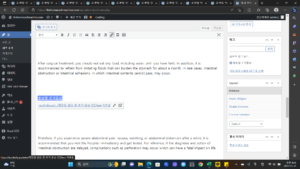Today, we will learn more about appendicitis, which has a relatively high percentage of young patients from teens to 30s. First of all, the exact name of the disease is appendicitis, and it is one of the diseases that can cause serious sequelae if appropriate measures are not taken when symptoms occur.
It is often said that the appendix has burst when the disease occurs. However, this is a misnomer (when the appendix ruptures, the contents of the intestine flow into the peritoneum and lose life due to bacterial infection), and appendicitis means that the appendix attached to the end of the small intestine is inflamed, not burst.
location and symptoms
More than 95% of patients who come to the hospital with appendicitis complain of severe abdominal pain. So where exactly is the appendix located? This organ is mostly located in the right lower abdomen. Occasionally, it is said that the position of the appendix is different for men and women, but this is incorrect, and both men and women have the same structure as the right lower abdomen.
However, very rarely, a pregnant woman may experience a situation in which the organ shifts toward the epigastrium as her belly swells. Thus, if a pregnant woman appeals to extreme pain in the epigastrium, she may suspect appendicitis, and as soon as she feels the pain, call 119 or visit the emergency room to take appropriate measures.
As mentioned earlier, as an early symptom of appendicitis, more than 95% of patients feel extreme pain in the right lower abdomen. When abdominal pain is felt for the first time, the location of the pain is often vague. However, it gradually appears to be confined to the right flank. In addition, about 80% of patients will have body changes such as vomiting, anorexia, nausea, and fever.
For reference, if the pain appears strong when you press the right lower abdomen with your fingertips and then release your hand (rebound pain), or if the pain decreases when you bend your knee and excruciating pain occurs when you straighten your knee, it is very likely appendicitis. Therefore, if the symptoms mentioned above appear in the body, it is recommended to visit the emergency room immediately.
how to cope
If appendicitis is in the early stages or if the symptoms are very minor, antibiotics can be administered. However, most patients with appendicitis perform surgical treatment to remove the appendix. Recently, abdominal surgery with less scarring and quick recovery is mainly performed, and if inflammation forms an abscess, drainage is performed using a drainage tube and antibiotics are administered to subside the inflammation first.
After surgical treatment, you should not eat any food, including water, until you have farts. In addition, it is recommended to refrain from irritating foods that can burden the stomach for about a month. In rare cases, intestinal obstruction or intestinal adhesions, in which intestinal contents cannot pass, may occur. .

Therefore, if you experience severe abdominal pain, nausea, vomiting, or abdominal distension after a while, it is recommended that you visit the hospital immediately and get tested. For reference, if the diagnosis and action of intestinal obstruction are delayed, complications such as perforation may occur, which can have a fatal impact on life.